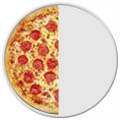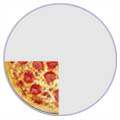Decimals, Fractions and Percentages
Decimals, Fractions and Percentages are just different ways of showing the same value:
 |
| A Half can be written... |
| |
| As a fraction: |
1/2
|
| As a decimal: |
0,5
|
| As a percentage: |
50%
|
|
 |
| A Quarter can be written... |
| |
| As a fraction: |
1/4
|
| As a decimal: |
0,25
|
| As a percentage: |
25%
|
|
Here is a table of commonly used values shown in Percent, Decimal and Fraction form:Example Values
| Percent | Decimal | Fraction |
|---|
| 1% | 0,01 | 1/100 |
| 5% | 0,05 | 1/20 |
| 10% | 0,1 | 1/10 |
| 12½% | 0,125 | 1/8 |
| 20% | 0,2 | 1/5 |
| 25% | 0,25 | 1/4 |
| 331/3% | 0,333... | 1/3 |
| 50% | 0,5 | 1/2 |
| 75% | 0,75 | 3/4 |
| 80% | 0,8 | 4/5 |
| 90% | 0,9 | 9/10 |
| 99% | 0,99 | 99/100 |
| 100% | 1 | |
| 125% | 1,25 | 5/4 |
| 150% | 1,5 | 3/2 |
| 200% | 2 | |
DECIMALS
| Definition: | A decimal is any number in our base-ten number system. Specifically, we will be using numbers that have one or more digits to the right of the decimal point. The decimal point is used to separate the ones place from the tenths place in decimals. As we move to the right of the decimal point, each number place is divided by 10. |
| Mixed Number | ------------- E x p a n d e d F o r m ------------ | Decimal Form |
 | = (5 x 10) + ( 7 x 1) | + (4 x  ) + (9 x ) + (9 x  ) ) | = 57.49 |
As you can see, it is easier to write  in decimal form. Let's look at this decimal number in a place-value chart to better understand how decimals work. in decimal form. Let's look at this decimal number in a place-value chart to better understand how decimals work. |
| PLACE VALUE AND DECIMALS |
 |  |  |  |  |  |  |  |  |  |  |  |  |  |
| | | | | 5 | 7 | . | 4 | 9 | | | | |
| As we move to the right in the place value chart, each number place is divided by 10. For example, thousands divided by 10 gives you hundreds. This is also true for digits to the right of the decimal point. For example, tenths divided by 10 gives you hundredths. When reading decimals, the decimal point should be read as "and." Thus, we read the decimal 57.49 as "fifty-seven and forty-nine hundredths." Note that in daily life it is common to read the decimal point as "point" instead of "and." Thus, 57.49 would be read as "fifty-seven point four nine." This usage is not considered mathematically correct. |
Example 1: Write each phrase as a fraction and as a decimal.
| phrase | fraction | decimal |
| six tenths |  | .6 |
| five hundredths |  | .05 |
| thirty-two hundredths |  | .32 |
| two hundred sixty-seven thousandths |  | .267 |
So why do we use decimals?
| Decimals are used in situations which require more precision than whole numbers can provide. A good example of this is money: Three and one-fourth dollars is an amount between 3 dollars and 4 dollars. We use decimals to write this amount as $3.25.A decimal may have both a whole-number part and a fractional part. The whole-number part of a decimal are those digits to the left of the decimal point. The fractional part of a decimal is represented by the digits to the right of the decimal point. The decimal point is used to separate these parts. Let's look at some examples of this. |
| decimal | whole-number part | fractional part |
| 3.25 | 3 | 25 |
| 4.172 | 4 | 172 |
| 25.03 | 25 | 03 |
| 0.168 | 0 | 168 |
| 132.7 | 132 | 7 |
Let's examine these decimals in our place-value chart.
| PLACE VALUE AND DECIMALS |
 |  |  |  |  |  |  |  |  |  |  |  |  |  |
| | | | | | 3 | . | 2 | 5 | | | | |
| | | | | | 4 | . | 1 | 7 | 2 | | | |
| | | | | 2 | 5 | . | 0 | 3 | | | | |
| | | | | | 0 | . | 1 | 6 | 8 | | | |
| | | | 1 | 3 | 2 | . | 7 | | | | | |
| Note that 0.168 has the same value as .168. However, the zero in the ones place helps us remember that 0.168 is a number less than one. From this point on, when writing a decimal that is less than one, we will always include a zero in the ones place. Let's look at some more examples of decimals. |
Example 2: Write each phrase as a decimal.
| Phrase | Decimal |
| fifty-six hundredths | 0.560 |
| nine tenths | 0.900 |
| thirteen and four hundredths | 13.040 |
| twenty-five and eighty-one hundredths | 25.810 |
| nineteen and seventy-eight thousandths | 19.078 |
Example 3: Write each decimal using words.
| Decimal | Phrase |
| 0.0050 | five thousandths |
| 100.6000 | one hundred and six tenths |
| 2.2800 | two and twenty-eight hundredths |
| 71.0620 | seventy-one and sixty-two thousandths |
| 3.0589 | three and five hundred eighty-nine ten-thousandths |
It should be noted that five thousandths can also be written as zero and five thousandths.
Expanded Form
| We can write the whole number 159 in expanded form as follows: 159 = (1 x 100) + (5 x 10) + (9 x 1). Decimals can also be written in expanded form. Expanded form is a way to write numbers by showing the value of each digit. This is shown in the example below. |
Example 4: Write each decimal in expanded form.
| Decimal | | Expanded form |
| 4.1200 | = | (4 x 1) + (1 x  ) + (2 x ) + (2 x  ) ) |
| 0.9000 | = | (0 x 1) + (9 x  ) ) |
| 9.7350 | = | (9 x 1) + (7 x  ) + (3 x ) + (3 x  ) + (5 x ) + (5 x  ) ) |
| 1.0827 | = | (1 x 1) + (0 x  ) + (8 x ) + (8 x  ) + (2 x ) + (2 x  ) + (7 x ) + (7 x  ) ) |
Decimal Digits
In the decimal number 1.0827, the digits 0, 8, 2 and 7 are called decimal digits.
| Definition: | In a decimal number, the digits to the right of the decimal point that name the fractional part of that number, are called decimal digits. |
Example 5: Identify the decimal digits in each decimal number below.
| Decimal Number | Decimal Digits |
| 1.40000 | 1.40000 |
| 359.62000 | 359.62000 |
| 54.00170 | 54.00170 |
| 0.72900 | 0.72900 |
| 63.10148 | 63.10148 |
Types of Decimal Numbers
Exact Decimal
The decimal part of an exact decimal number is composed of a finite number of digits.
Repeating Decimal or Recurring Decimal
1
The decimal part, called the period, is repeated endlessly.
2
The decimal part is composed of an irregular part and a regular part, also known as a period.
Not Exact and Non-Recurrent

